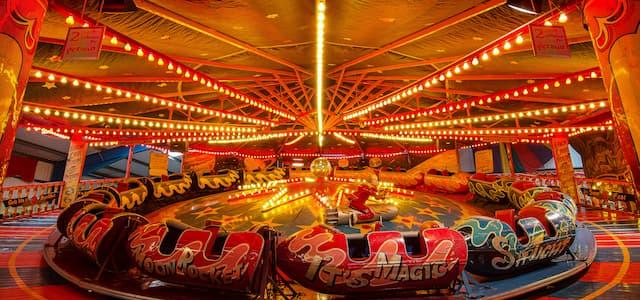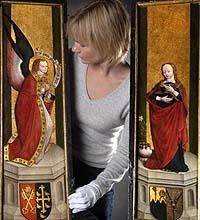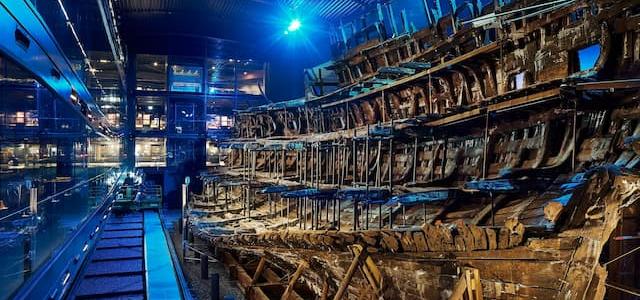
Medieval panel show
Museum of London wins medieval panel show.

An exquisite pair of late 15th-century altar paintings, on oak panels, believed to have furnished a chapel at Westminster Abbey, are to take pride of place at Museum of London from Saturday 9 December. The acquisition of this rare example of late 15th-century Christian art has been made possible with a grant of £100,000 from the National Heritage Memorial Fund (NHMF), £56,430 from The Art Fund, £15,000 from The Pilgrim Trust and generous funding from private donors. The panels will add a little grandeur, alongside the glamour, sleaze and disease which make up the Museum’s story of medieval life in the capital.
The panels would originally have formed the wings of an altarpiece. Adorned with the shields of arms of Westminster Abbey and George Fascet, Abbot from 1498-1500, the oil painted panels represent the high quality religious artwork available to wealthy medieval Londoners. The Annunciation scene is depicted in glowing colours, with the Archangel Gabriel on the left panel and the Virgin Mary on the right, and is beautifully preserved. Illuminated by candles in its original setting, the ‘cloth of gold’ ground would have provided a shimmering setting against which the figures would appear to step out toward the viewer with an uncanny, lifelike quality.
The artefact’s London homecoming completes a tale of extraordinary and unlikely survival which saw the panels pass intact through the cataclysmic upheavals of Reformation, the Dissolution of the Monasteries and religious turmoil. These are key themes in the Museum’s medieval London gallery, but the objects currently on display are generally of a much smaller and more personal nature. The Westminster Panels will complement these displays and specifically convey the importance of religion for the higher social classes. Their connection with a documented London figure and one of medieval London’s most important establishments, make them an outstanding and extremely important addition to the Museum’s collection.
John Clark, curator of Museum of London’s medieval London gallery said, “Acquiring the Westminster Annunciation panels for the Museum will ensure that this outstanding and fascinating example of high quality religious painting will be made accessible to the general public, as the centrepiece of a permanent display. This display will interpret the work in the wider context of religion in the medieval city and will illustrate the overriding importance of faith and worship across the social spectrum of Londoners.”
Acknowledging the grant Stephen Johnson, Head of the NHMF, said, "These beautiful altar panels seem to have been painted in London around 1500 and are now coming back to the capital, where they clearly belong. Religious paintings of this date from England are rarities, and this grant from the National Heritage Memorial Fund will enable them to contribute to the story of medieval London within the Museum's recently revitalised displays."
David Barrie, Director of The Art Fund said, "The Art Fund was determined to secure The Westminster Panels – not only do they allow us a rare and vivid glimpse of medieval English devotional art but they are also things of great beauty. The strong connection with London makes the Museum of London the perfect home."
The panels will be put on individual display in the Museum before taking their place adjacent to cases dealing with Henry VIII’s Dissolution of the Monasteries and the Protestant/Catholic conflicts of the ensuing reigns of Edward VI and Mary. The panels will reflect the splendour of an established church and a social system that came to a dramatic end during these 50 years – events emphasised in school history syllabuses and in the Museum’s educational programmes on the Tudors.
Notes to editors
The Westminster Panels
The Westminster Panels were commissioned by or for George Fascet, Abbot of Westminster, 1498-1500. It is most likely that they furnished a chapel in the Abbey, but it is possible that they were made to adorn a portable altar for the Abbot on his travels. The central panel is lost but would probably have depicted The Virgin and Child.
George Fascet became a monk at Westminster Abbey in 1472-3. His name appears in the abbey’s records spelt variously Fascet, Fasset, Fassett, Facet or Facett. One document contains what seems to be his personal motto, punning in Latin on his name – ‘geras te facete’ – ‘bear yourself elegantly’. He became prior, the abbey’s second most senior official, in 1491. From 1497 to 1500 he was also ‘Warden of the New Work’, in charge of all the abbey building projects. In July 1498 he was elected abbot. However, he seems to have been chronically ill, and spent much of his short period as abbot in the abbey infirmary. He died, probably only in his forties, in late summer 1500. He was buried in the chapel of John the Baptist, in the north ambulatory of the choir of the abbey church.
Museum of London
Museum of London is the only museum to tell the story of London from pre-historic times to the present day. Find out what Romans ate for dinner, experience the Great Fire of London, go window-shopping in our Victorian walkway and be amazed by the magnificent Lord Mayor’s coach. Admission is free. To hear about our exciting events programme and start exploring London’s history and the histories of Londoners visit. www.museumoflondon.org.uk or call 0870 444 3851.
The Art Fund
The Art Fund is the UK’s leading independent art charity. It offers grants to help UK museums and galleries enrich their collections and campaigns widely on behalf of museums and their visitors. It has 80,000 members. Since its foundation in 1903, The Art Fund has helped UK public collections acquire over 850,000 works of art, ranging from Bronze Age treasures to contemporary works of art. In 2005 The Art Fund offered over £4.1million to museums and galleries and distributed 12 gifts and bequests. Independent of government, The Art Fund was at the forefront of the campaign for free admission in 2001 and the campaign to save the Macclesfield Psalter in 2005.
The Pilgrim Trust
The Pilgrim Trust is a long established, endowed grant making trust that supports heritage and social welfare projects. It spends in the region of £1.5million a year on a variety of different projects that fall within its current priorities.
Further information
Tim Morley
Phone: 020 7814 5607 (tmorley@museumoflondon.org.uk)
Museum of London,
London Wall,
London EC2Y 5HN
Open Monday to Saturday 10am-5.50pm, Sunday 12-5.50pm
Admission FREE
Recorded information: 0870 444 3851 www.museumoflondon.org.uk
Tube: St Paul’s, Barbican and Moorgate
Visit Belonging: Voices of London's Refugees - a new thought-provoking free exhibition
Glamour, grandeur, sleaze, disease - discover a great city in the making in the new Medieval London gallery. Register for regular Museum updates with enews@museumoflondon.org.uk
Alison Scott or Dervish Mertcan, NHMF Press Officers
Phone: 020 7591 6032 / 6102. Mobile: 07973 613 820

